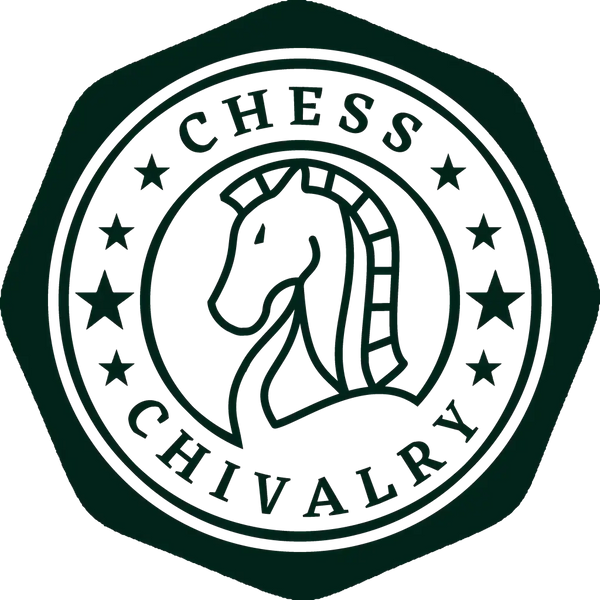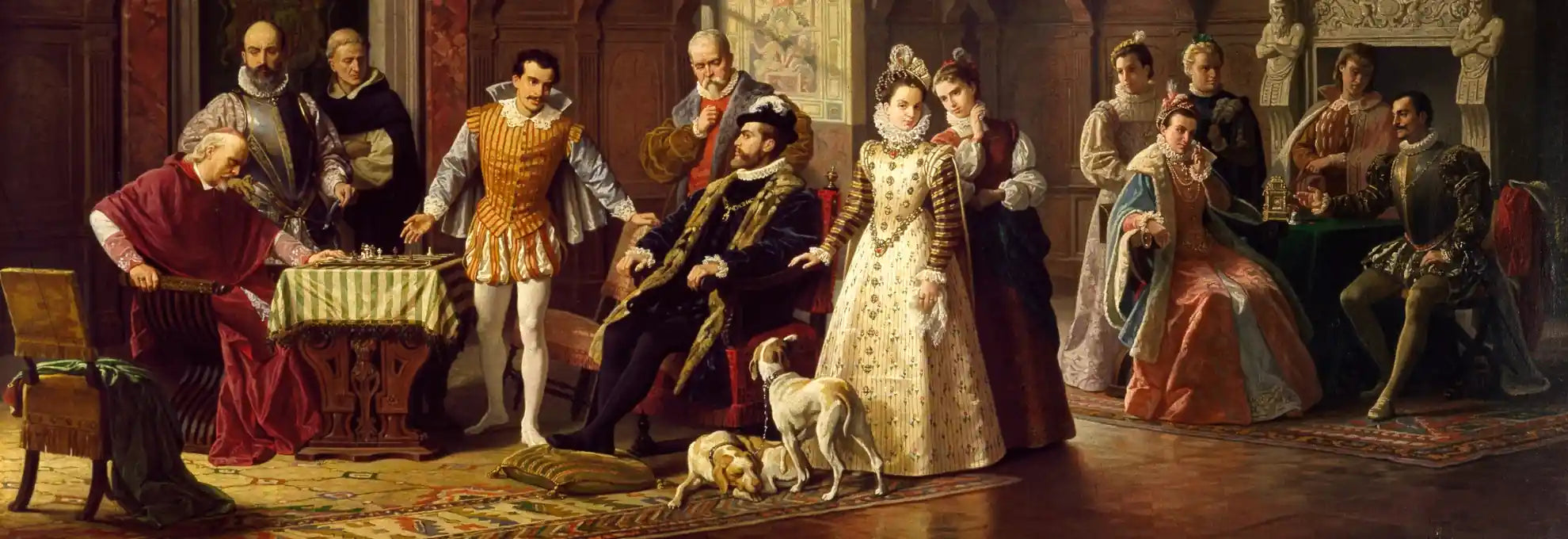
The History of Chess
The exact origin of chess can no longer be determined, despite its high popularity. The first mentions of the game found about 600 years AD. Chr. in the north of India. It is highly probable that chess developed from the game "Chaturanga", which was played in India at that time and meant something like "Four Elements" or "Four Parts". The game referred to the four units of the Indian armies: infantry, cavalry, chariots and elephants, which, as in chess, were moved on a playing field with 64 squares. However, since the exact rules have not been preserved, the connection between the games is unfortunately not provable and can only be very vaguely conjectured. Moreover, it is also assumed that the term "Chaturanga" in many historical records refers to the Indian army itself rather than the military-style board game. Nevertheless, it can be ruled out that the game has a single originator, since in addition to its high complexity, it also has many cultural as well as historical references that are far apart in time.
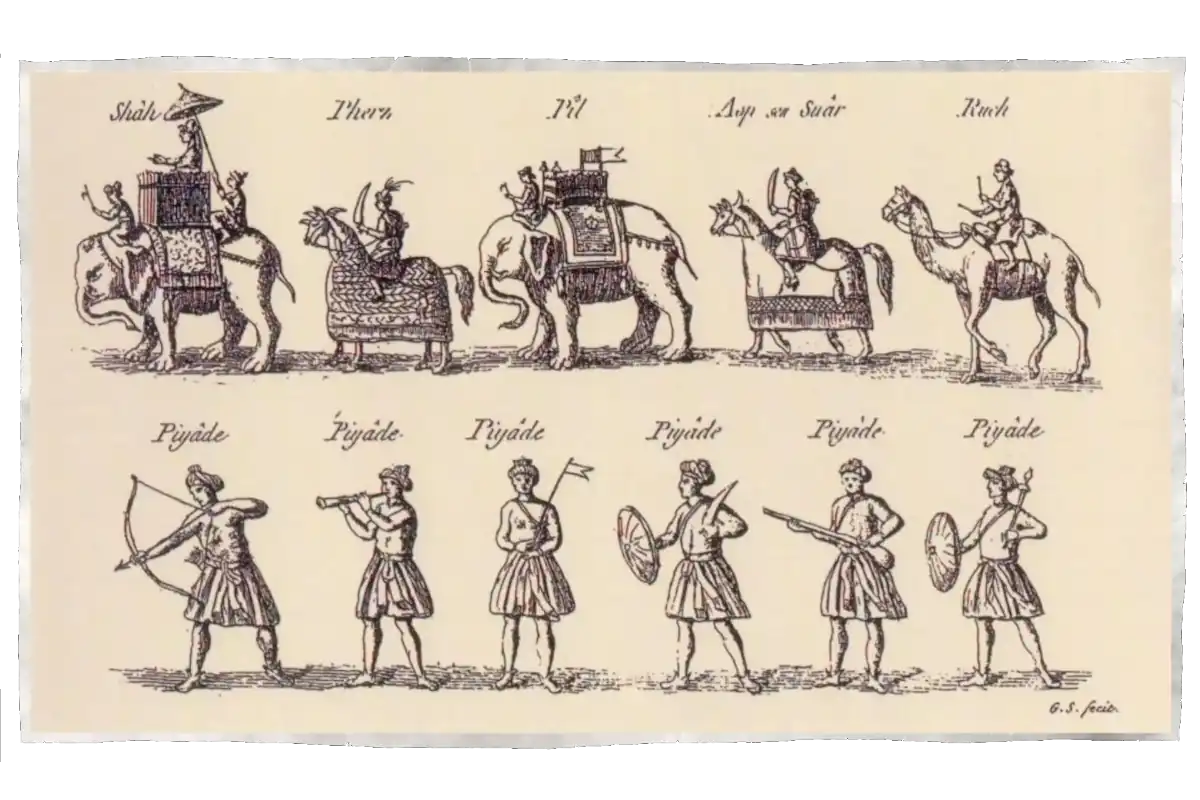
Early Shatranj Game Pieces
Illustration of Shatranj pieces in the book "Mandragorias, seu, Historia shahiludii"
by Thomas Hyde in the year 1694
6th Century: Chatrang Reaches Persia
Around the middle of the 6th century, the Indian king Divsaram gave the Persian court a war game called "Chatrang". It is believed that "Chatrang" was a slightly modified version of "Chaturanga", as the game pieces had other names: king, commander, elephant, horse and foot soldier. The game was very popular, and its popularity was most likely promoted by the then ruling and culturally very interested King Chosraus I, who also gave the game a high social status. Therefore, players who mastered chess were highly respected, and several writings have survived in which the game is mentioned along with other culturally established games of the time. The terms "chess" and "mate" also have their origins in the Persian language. "Chess" translates as "shah," which means "king." "Mate," on the other hand, can be interpreted from the Persian "mat" as "helpless, beaten or abandoned." "Checkmate" in the context of the game thus means something like "Shah Mat": "The king is abandoned to his fate." The paraphrase refers to the rule that the king is not directly defeated, but the game ends as soon as he gets into a hopeless situation.
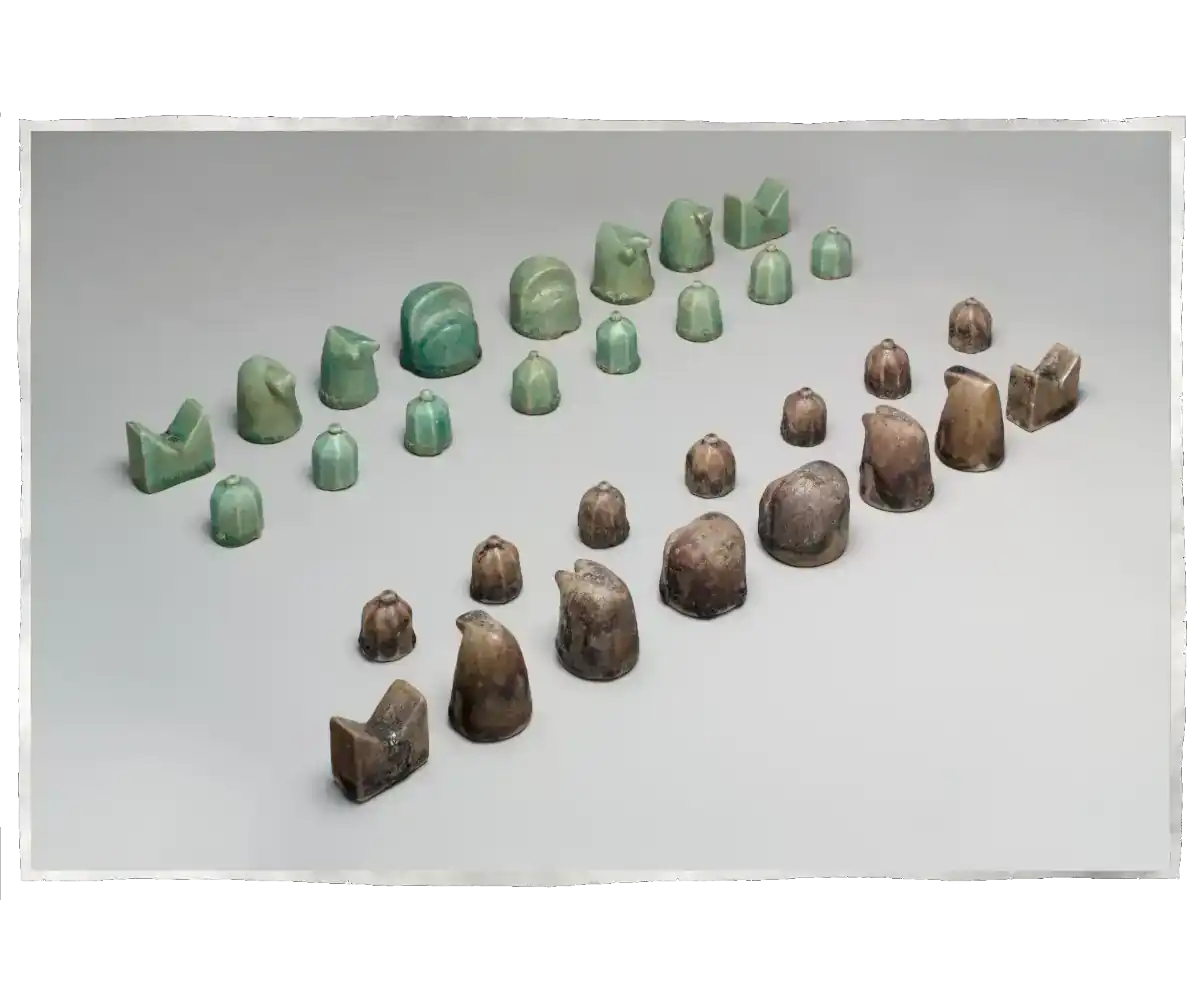
Chess Set, 12th Century, Iran
A well-preserved 12th century chess set from Nishapur, Iran, on display at the Metropolitan Museum of Art. At that time, the pieces had different shapes. The king and queen were represented with thrones of different sizes. The bishop was an elephant with two tusks, the knight was depicted as a horse, as it is today, and the rook had a V-shaped figure. The pawns were represented as hemispheres with knobs at the top.
7th century: Spread from Arabia to the World
In the first half of the 7th century, the Arabs conquered the Sassanid Empire and came into contact with the game now called "Shatranj" due to linguistic modification. As in Persia, the game gained great popularity in the Arab world and became a cultural asset. Thus Arabic records report for the first time of famous players such as: al-Adli, ar-Razi or Mawardi and professional players, who occupied themselves extensively with the art of play. At that time, entire treatises on opening strategies, endgame positions, tactics and even the first links to mathematics were written down. Since the rules of the "Shatrandsch" have been preserved and they show an obvious similarity to the later game of chess, the Arabic variant of the game shows the clearest connection to the Indian origin of chess.
The wheat grain legend is also attributed to the Arab region and at the same time confirms the connection with India. According to this legend, there was once an Indian ruler named Shihram who did not live up to his position as ruler and tyrannized his people. The Brahmin Sissa then developed a game for the king to show him the duties and responsibilities of all the people of his nation and how he should rule them. Impressed by the game, King Shihram slowly became aware of his responsibilities and had the game spread throughout his kingdom. In return for the game and the lesson he had learned, the king granted Sissa a wish. Sissa asked for an ever-increasing amount of wheat grains, doubling from chess square to chess square, starting with a single grain. The king was amazed at the supposed modesty and asked the mathematician and the overseer of the granary to provide the desired quantity. Unfortunately, this was not possible, because the quantity was more than 18 trillion grains of wheat, or in other words 730 billion tons. This should once again make the king aware of the complexity of his leadership responsibility. The originators of the legend are most likely the poet as-Sabhādī, who came from Baghdad, and the biographer Ibn Challikān, who came from Erbil.
Until the 9th century Baghdad developed more and more into the cultural center of Islam and was the destination of many travelers and the starting point of countless trade routes. Trade caravans brought the Persian chess variant across the Asian region to Japan and along more northern routes from Constantinople to Russia. Over the Berber tribes of North Africa, chess reached Spain, where the highly gifted and very famous musician of the time, Abul-Hasan Alí Ibn Nafí, who was born in Iraq and sent to Andalusia by the caliph for his talents, further cultivated the game and promoted its fame.
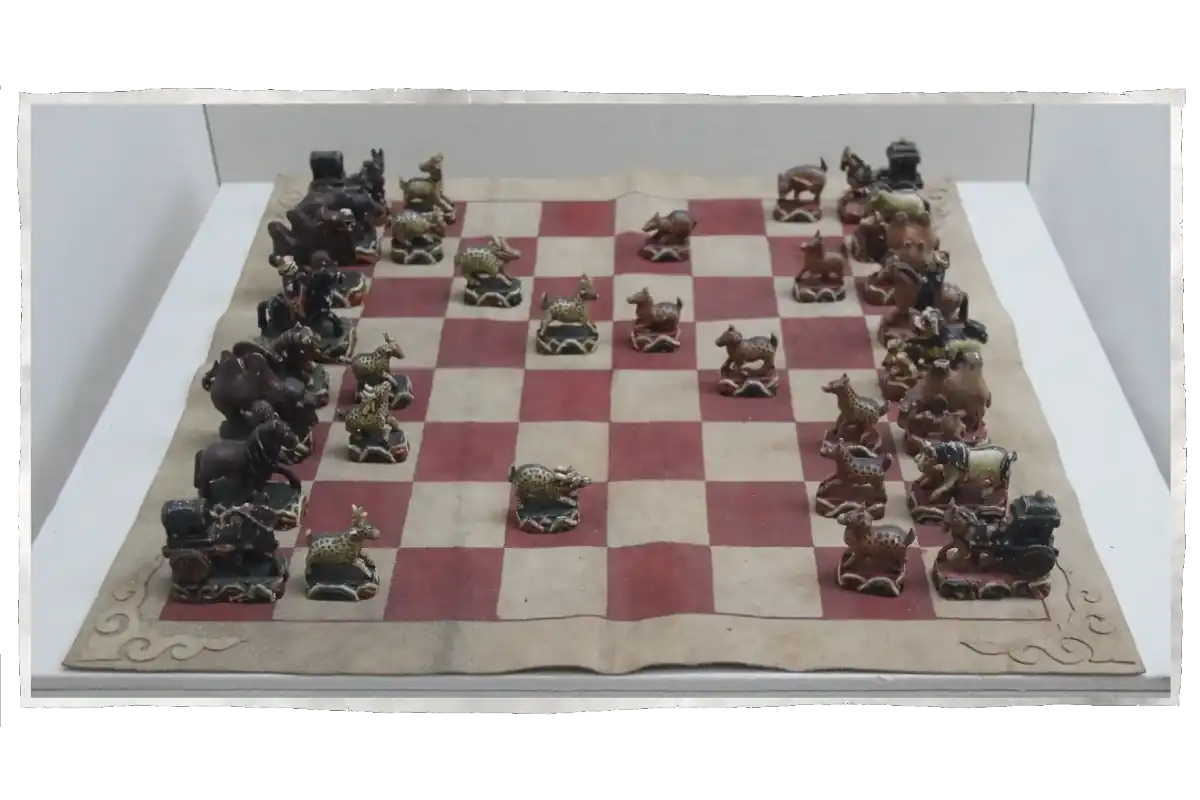
Mongol Chess Set, Qing Dynasty
A Monglian chess set from the Qing dynasty. The rules are very similar to international chess, although the pieces have different shapes. The game is called Shatar in Mongolia, another game variant with 10 x 10 boards is called Hiashatar.
13th Century: Rise and Popularity in Europe
By the 13th century, the game had spread further to France, Italy and as far as Iceland. It was during this period that the game openings, still known today and named after their countries of origin, were created. Despite objections and repeated prohibitions by the church on the grounds that chess was similar to gambling and would distract people from their duties, the game prevailed. As in the centuries before, the prestige of chess increased throughout Europe and was even elevated to one of the seven chivalric virtues. Thus, in 1330, the Dominican friar Jacobus de Cessolis wrote a detailed interpretation of chess in his work "Liber de moribus hominum et officiis nobilium ac popularium super ludo scacchorum" (Translated: A Book on the Character of Men and the Duties of the Nobility and the Common People in Playing Chess) a detailed interpretation of chess, referring to the roles and duties in society represented by the game pieces. Because of its socially critical traits and emphasis on solidarity rather than hierarchy, the work was very popular and one of the most widely read of the Middle Ages.
In 1473, the first printed edition was published in Utrecht.
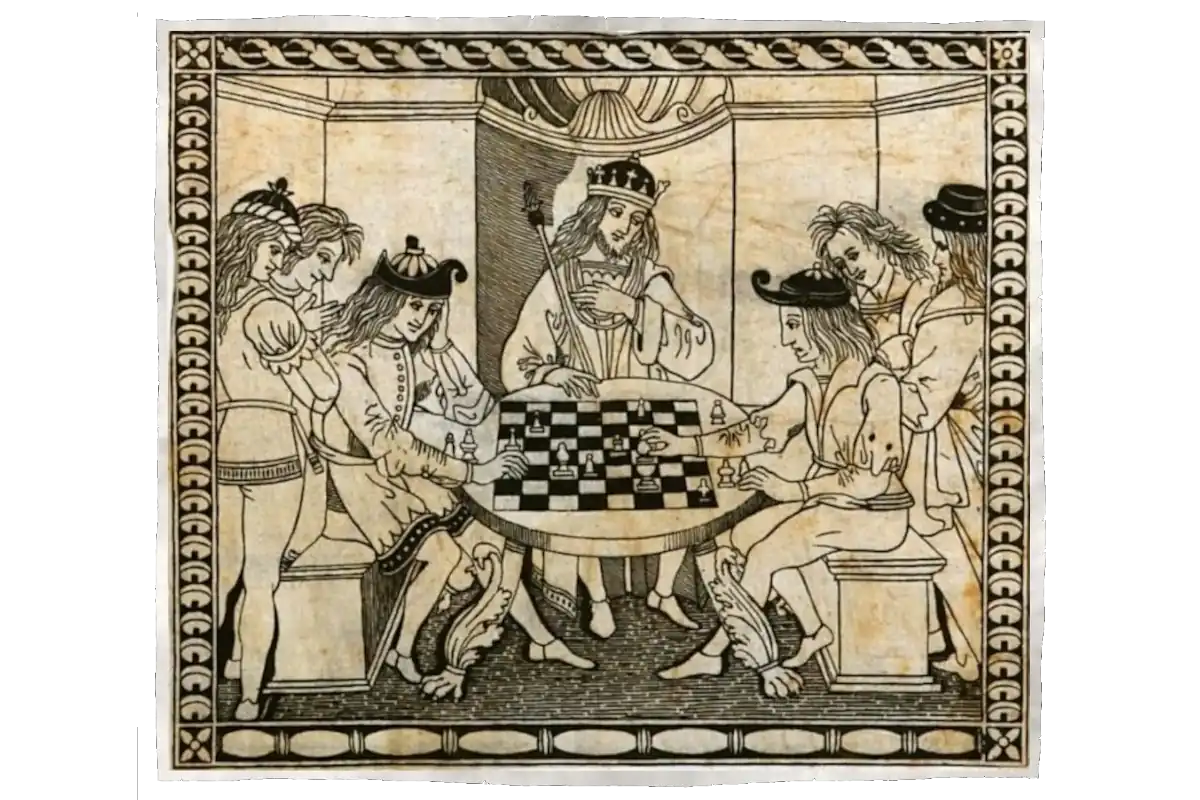
The Reputation of Chess
The illustration of the chess game by the Dominican Jacobus de Cessolis in his book: "A Book on the Character of Men and the Duties of the Nobility and the Common People at Chess", 1473.
15th century: Politics and New Rules
By the end of the 15th century, significant rule changes took place that made chess what it is today. The pawns got their double move and their promotion at the end of the board, while the bishop as well as the queen were allowed to move unlimitedly in their directions of movement. The queen in particular thus became the most powerful piece on the board, although the reasons for the strengthening of its power are not precisely documented. However, there are several assumptions that can be traced back to historical figures. For example, strong queens came to power in the Middle Ages, including Eleanor of Aquitaine, Blanka of Castile, and especially Isabella I, who exerted a high political influence on the course of history. The cultural anchoring of the Virgin Mary may also have influenced the rule change. In addition, long before the rule change, the importance of a queen to the king was romantically considered essential for survival. If the king loses his queen or his great love, nothing of value remains on the board for him. The new position of the queen in chess opened up completely new tactical and strategic possibilities, with which first the European and later players worldwide tried to contend with each other.
Until the 18th century, the Italians held a dominant position in chess and tactical literature, until the chess scene in France produced renowned players and became the European chess center. In particular, the "Café de la Régence" was the meeting place of many top players such as Paul Morphy, José Raúl Capablanca and Pierre Charles Fournier de Saint-Amant. Even celebrities like Napoleon Bonaparte, Karl Marx and Friedrich Engels moved their pieces across the board at this place. A curiosity from that time was the "Mechanical Turk" built by Wolfgang von Kempelen. This was a chess robot that, in the guise of a man dressed in Turkish and sitting in front of a box, could apparently play against real players without much thought and, in most cases, win. It was only a few decades later that the secret was revealed, and it turned out that people were hiding in the box and transmitting their moves to the robot's hand movements by a complicated mechanism. Although the secret was not a big surprise, it was remarkable that such a complicated mechanism was developed just for a scam and that for it players were found who could withstand the challengers internationally and even defeat them.
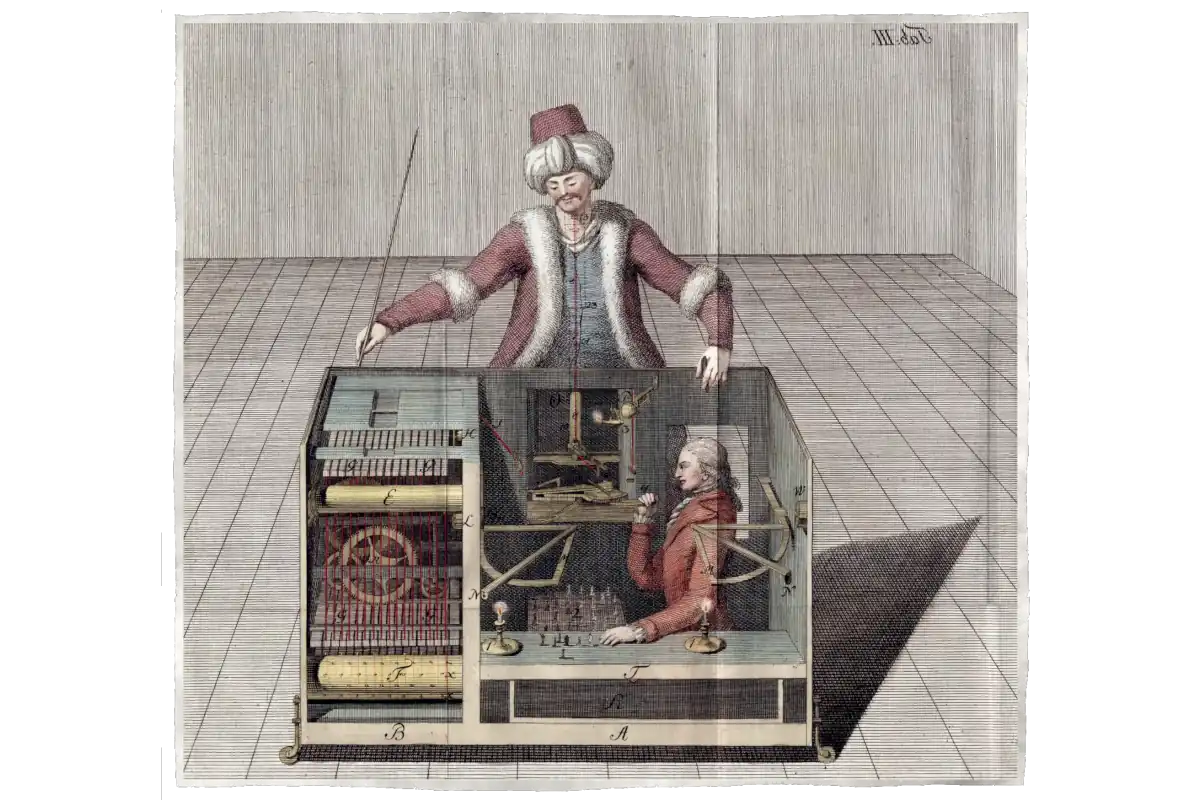
Mechanical Turk
A cross-section of Joseph Friedrich Freiherr von Racknitz, showing his conjectures about how the mechanical Turk works. One of many illustrations by artists of the time with the purpose of revealing the mystery.
19th century: The first World Chess Championship
In the 19th century, chess continued its triumphal march and became a favorite game of the citizens. Chess magazines regularly reported on new strategies and tactics and an increasing number of competitions and tournaments were held. In 1849, Nathaniel Cook registered a famous design for chess pieces, which was then adopted by John Jaques of London for the distribution of chess pieces and officially recommended by FIDE for chess playing all over the world. To deter imitators and promote the popularity of the chess pieces, Cook had the leading player of the day, Howard Staunton, sign the certificates of authenticity for the pieces and even named the pieces after him: the Staunton Chess Pieces. It was also the first time that the World Chess Championship was held, which Wilhelm Steinitz won against Johannes Hermann Zukertort in 1886. He retained his crown until Emanuel Lasker took the title from him in 1894 and subsequently defended it in a record time that is still valid today. It was not until 1921, 27 years after his victory over Steinitz, that Lasker lost to José Raúl Capablanca in the World Championship match in Havana.
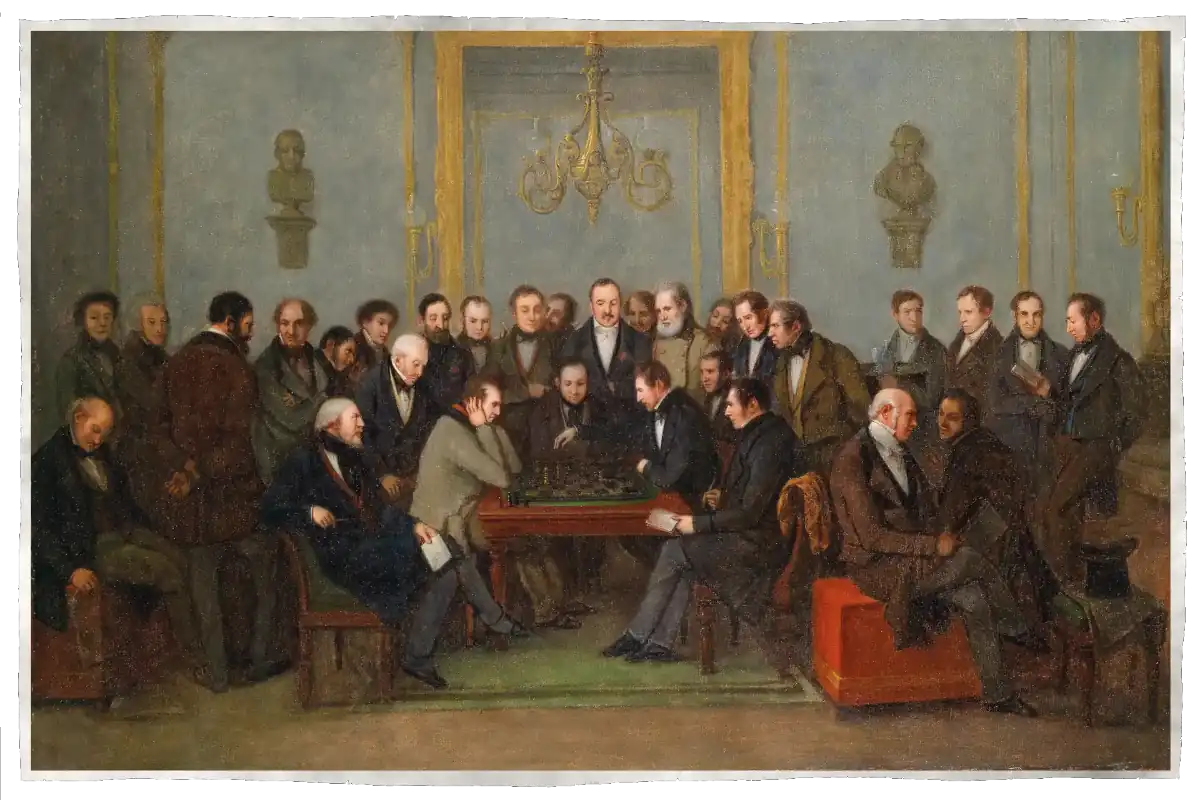
Staunton vs. Saint-Amant
An illustration by Jean Henri Marlet shows a match between Howard Staunton and Pierre Charles Fournier Saint-Amant on December 16, 1843.
20th century: Cold War and Artificial Intelligence
The professionalization of chess continued to increase in the 20th century. International tournaments were held more frequently, chess leagues were founded and literature on chess compositions became more popular. The rise of chess led, among other things, to the founding of the international chess federation "Fédération Internationale des Échecs" (FIDE) in 1924 and to the holding of the Chess Olympiads from 1927. Through state subsidies, Russia took on a pioneering role in the training of chess talents and dominated the competition from the 1950s onwards. Because of the high standing chess acquired among the general public, a fierce competition developed between the Western and Eastern powers, culminating in the match of the century between Bobby Fischer and Boris Spassky in the 1972 World Championship final in Reykjavík. The match itself was exploited propagandistically as a proxy battle of the Cold War, with each side trying to prove that its respective system was superior. As a clash of two ideologies, Fischer represented capitalism and Spassky represented communism. Away from the match, the event was marked by Fischer's antics. Typical of him and favored by his high position in chess as the only worthy Western contender for the title, he acted in an eccentric manner. So he successfully demanded an increase in the prize money, made the journey to the tournament venue delayed and only after being asked to do so by Henry Kissinger himself, and after losing the second game demanded that the match should be played in a separate room. Fischer's demeanor, as always, had an intimidating and unsettling effect on his opponents, which also troubled Spassky. And after Fischer's victory in the third game, the tide finally turned in his favor. After a total of 21 games played between July 11 and August 31, the world champion was crowned: Bobby Fischer defeated Boris Spassky. The naming of the event as the Game of the Century actually fulfilled the expectations of the worldwide audience at the time. Both players contested the final at the peak of their skills and offered the world a drama that left nothing to be desired. Chess gained a vibrant following through this match and was able to increase its popularity again, even if the accompanying political circumstances were less conducive to its reputation.
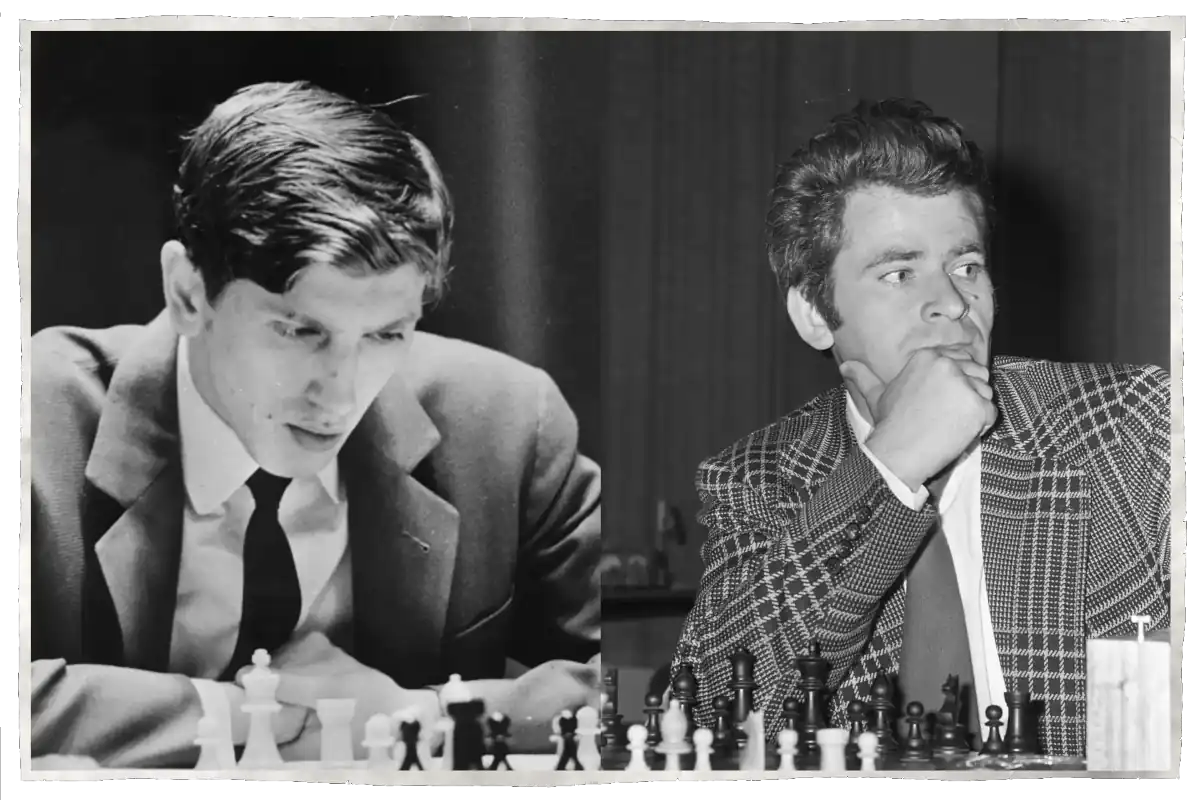
The Match of the Century
Bobby Fischer (l.), amid great media hype, defeated Boris Spassky (r.) and decided the "cold" proxy war for the West. Both opponents played at the top level and fulfilled the worldwide expectations for the "match of the century"
Toward the end of the century, the battle between man and machine proved even more fascinating than a political conflict. The reigning world champion Garry Kasparov, experienced in competing against chess computers and confident that he would never be defeated by one, faced Deep Blue, a chess computer developed by IBM, in 1996. Amid much media attention, Deep Blue won the first game, but lost three more and managed only two draws. Regardless of the computer's defeat, the main focus was on the first game that Deep Blue won, which showed that a computer could beat the world champion. With this insight, IBM equipped Deep Blue with even more powerful hardware and optimized the software. Just one year later, in 1997, Deep Blue beat Garri Kasparov in six games under tournament conditions. Kasparov was upset by his defeat and accused IBM of helping the computer. Only 20 years later he revised this statement and confirmed that he had not been cheated.
21st century: Internet and Growing Popularity of Chess
The 21st century brought chess a worldwide breakthrough with the advent of the Internet, which made it possible for anyone around the globe to play chess without any barriers. Providers of chess portals also made it possible to learn the game in a very short time and to gain a comprehensive and - at least compared to the time before the Internet - advanced understanding of tactics and strategy. It also produced a number of great chess players. Vladimir Kramnik and Viswanathan Anand, for example, dominated the chess world at the beginning of the century until 2013, when chess prodigy Magnus Carlsen set new standards. With the outbreak of the Corona pandemic in the early 2020s, the popularity of chess rose again, although under less fortunate circumstances. This was due to the restrictions on outdoor activities at the height of the pandemic, which had greatly increased the demand for digital entertainment. But coverage and entertainment formats also increased significantly, creating prominent personalities on media portals that will carry chess into the future with confidence.
